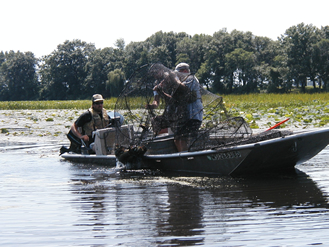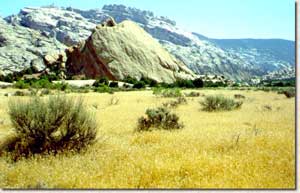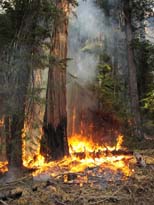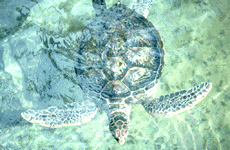- Home
- About S&T
- Taxa/Organisms
- Ecosystems
- Issues
- Methods & Tools
- Reports & Publications
- Location
- Search
Publisher: USGS | Science Center: Upper Midwest Environmental Sciences Center (UMESC, LaCrosse) | Format: URL
www.umesc.usgs.gov — This web resource provides decision makers with the information needed to maintain the Upper Mississippi River System as a viable multiple-use large river ecosystem. This resource also includes Data and sampling information, publication links, reports, other related documents and statistics, as well as links to field stations and other projects More...

Publisher: USGS | Science Center: Fort Collins Science Center (FORT, Ft. Collins) | Format: URL
www.fort.usgs.gov — The FORT research team will develop maps of invasive species at local, regional, and national scales and identify priority invasive species, vulnerable habitats, and pathways of invasion. County-level and point data on occurrence will be linked to plot-level and site-level information on species abundance and spread. Together, USGS, NASA, and CSU More...

September 2008 | Publisher: Other Federal Agency (United States Forest Service (USFS)) | Format: .PDF
www.fs.fed.us — This review of information on relationships between wildland fire and nonnative invasive plants can assist fire managers and other land managers concerned with prevention, detection, and eradication or control of nonnative invasive plants. The 16 chapters in this volume synthesize ecological and botanical principles regarding relationships between More...

Publisher: USGS | Science Center: National Wetlands Research Center (NWRC, Lafayette) | Format: URL
www.nwrc.usgs.gov — Cogongrass (Imperata cylindrica) is an agressive, perennial grass from Southeast Asia. Introduced into the United States on at least two separate occasions, this weed is currently invading Florida, Alabama, Mississippi, and Louisiana and has recently been discovered in East Texas. Cogongrass is considered one of the 10 worst weeds worldwide and is More...

Publisher: Other (National Invasive Species Information Center) | Format: URL
www.invasivespeciesinfo.gov — From the About NISIC. "The National Invasive Species Information Center (NISIC) was established in 2005 at the National Agricultural Library to meet the information needs of users including the National Invasive Species Council. ... NISIC creates and manages the www.invasivespeciesinfo.gov Web site. The Web site serves as a reference gateway to More...

Publisher: USGS | Science Center: Forest and Rangeland Ecosystem Science Center (FRESC, Corvallis) | Format: URL
fresc.usgs.gov — Periodic fire is a natural part of sagebrush steppe ecosystems in the Great Basin. However, a suite of human-caused factors has dramatically changed fire regimes in many of these systems. Decades of fire suppression and livestock grazing have produced dense, single-aged sagebrush stands and invasion by cheatgrass (Bromus tectorum) has increased More...

Publisher: USGS | Science Center: Northern Prairie Wildlife Research Center (NPWRC, Jamestown) | Format: URL
www.npwrc.usgs.gov — This resource is a species profile of the purple loosestrife (Lythrum salicaria), which is considered an invasive plant species. Its displacement of native species in wetlands has led to the loss of suitable habitat for wildlife. L. salicaria is the only reddish-purple flowered plant to develop massive monospecific blocks of showy floral displays More...

Publisher: USGS | Science Center: Western Ecological Research Center (WERC, Sacramento) | Format: URL
www.werc.usgs.gov — The Fire and Fire Surrogate study is a network of 13 long-term sites established nationwide to evaluate the ecosystem impacts of different fire hazard reduction treatment in forests that historically experienced short-interval, low- to moderate-severity fire regimes. The fuel reduction treatments being investigated by USGS researchers at Sequoia More...

Publisher: USGS | Science Center: Fort Collins Science Center (FORT, Ft. Collins) | Format: URL
www.fort.usgs.gov — This resource has been developed to provide source materials on the history of the invasion, continuing threats, research results, and containment and management of the brown Treesnake (Boiga irregularis) in Guam and its relevance to other islands and mild continental environments. Users can report snake sightings on this website, get information More...

Publisher: USGS | Science Center: Western Ecological Research Center (WERC, Sacramento) | Format: URL
www.werc.usgs.gov — This web resource addresses the positive relationship between cheatgrass (Bromus tectorum) and fire frequency as a major concern for land managers in semi-arid shrublands throughout western North America, particularly in Great Basin sagebrush steppe. Management tools are needed to break this cycle, and in this project we will evaluate the use of More...

Publisher: USGS | Science Center: Western Ecological Research Center (WERC, Sacramento) | Format: URL
www.werc.usgs.gov — Native amphibian and reptile populations worldwide are under threat from exotic invasive species of plants and animals, including other reptiles and amphibians. As habitats are changed and plant community organization is modified by exotic species, delicate relationships between plants and animals are altered or eliminated, creating a negative More...

Publisher: USGS | Science Center: Forest and Rangeland Ecosystem Science Center (FRESC, Corvallis) | Format: URL
srfs.wr.usgs.gov — The Snake River Birds of Prey National Conservation Area (NCA) has undergone massive habitat changes since 1980. Occupancy and productivity data have been collected at all eagle territories in the NCA since 1971, providing a wealth of background information. This issue overview continues the long-term assessments of territory occupancy and More...
